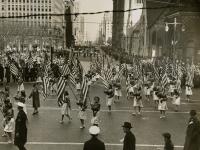Historians recognize a 1621 harvest celebration held by Pilgrims and the Wampanoag at Plymouth, in New England, as the occasion that birthed our American holiday. However, it was not until 1941 that Congress permanently established Thanksgiving in our national calendar. This week, let's review our Thanksgiving history and make sure students learn something new about the holiday!
The not-for-profit Plimouth Plantation offers a wonderfully concise and thorough history and description of our present day holiday. Click here to view the site, which includes images, primary sources and access to other educational resources.
Consider the development and spread of the American holiday across America throughout roughly four centuries. Reflect on your own family’s Thanksgiving tradition. Images of turkey dinner spreads, football, pumpkin pies, and family gatherings probably come to mind. Have your students, family and friends research the origins of their traditions. How is the food we eat for Thanksgiving a part of American history? Why does the holiday always fall on the fourth Thursday of November? Is Thanksgiving celebrated in other countries? Check out this teacher guide provided by the Library of Congress.
You can also find primary sources at HSP that will help students gain a historical perspective on what the observance of Thanksgiving looked like in the past. The following are a few examples:
See the proclamation given in 1868 by former Pennsylvania governor John W. Geary, which recommended all people “refrain from their usual avocations and pursuits, and assemble at their chosen places of worship to ‘praise the name of God and magnify Him with thanksgiving’.” Developing out of strict Puritan practices, Thanksgiving Day proclamations were given with a religious rhetoric even by our government officials. Today, things have changed. Religious affiliation varies from home to home; however the sentiment of giving thanks remains at the heart of the holiday.
By looking to HSP’s document, “A Thanksgiving Sermon” given in January of 1808, students can get an idea of what Thanksgiving meant for early African Americans. Considering African Americans had been disenfranchised with slavery and racism, how could the observance of government proclamations for the holiday have differed between black and white Americans? See this Thanksgiving Day Appeal by an Episcopal Freedman’s Commission, which used the holiday as an occasion to request school items to support education for African Americans.
Giving thanks is a theme familiar to all people. Uniting all the historical and present perspectives on a common ground, the sentiment and custom of giving thanks -with or without national holiday- are even older than this nation itself! Giving thanks has been an integral part of the native culture here in North America before the United States, and in Europe, the tradition of celebrating a plentiful harvest is as old as the actual harvest (predating the Middle Ages)! The Puritan presence in colonial and early America also cultivated the Thanksgiving tradition as an occasion to give solemn thanks for providence.
Check out this additional blog post to learn of historic examples in HSP’s archives to give thanks to for defending our nation. From the Historical Society of Pennsylvania to you and your students, we wish you a happy, productive and enlightened Thanksgiving weekend this year!
P.S. For those in the Philadelphia area, the Thanksgiving Day Parade, now in its 94th year, is the oldest of its kind in the nation. If you are in this area, share some fun facts on this local tradition and invite your students to go join in the festivities downtown and participate in this city’s history!

